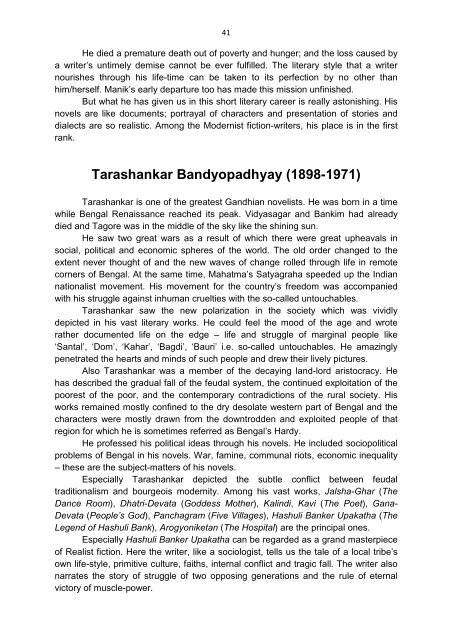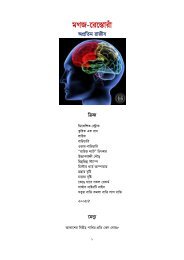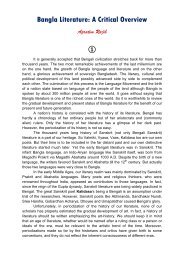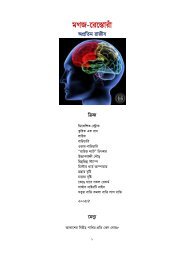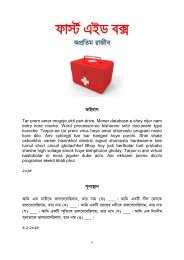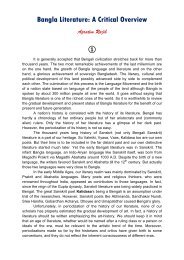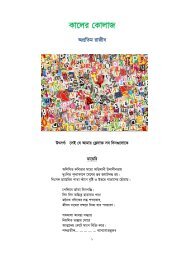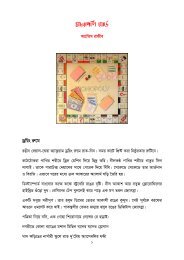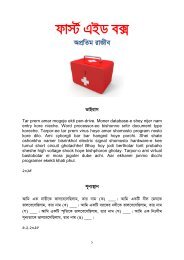BLiterature-Apratim
Create successful ePaper yourself
Turn your PDF publications into a flip-book with our unique Google optimized e-Paper software.
41<br />
He died a premature death out of poverty and hunger; and the loss caused by<br />
a writer’s untimely demise cannot be ever fulfilled. The literary style that a writer<br />
nourishes through his life-time can be taken to its perfection by no other than<br />
him/herself. Manik’s early departure too has made this mission unfinished.<br />
But what he has given us in this short literary career is really astonishing. His<br />
novels are like documents; portrayal of characters and presentation of stories and<br />
dialects are so realistic. Among the Modernist fiction-writers, his place is in the first<br />
rank.<br />
Tarashankar Bandyopadhyay (1898-1971)<br />
Tarashankar is one of the greatest Gandhian novelists. He was born in a time<br />
while Bengal Renaissance reached its peak. Vidyasagar and Bankim had already<br />
died and Tagore was in the middle of the sky like the shining sun.<br />
He saw two great wars as a result of which there were great upheavals in<br />
social, political and economic spheres of the world. The old order changed to the<br />
extent never thought of and the new waves of change rolled through life in remote<br />
corners of Bengal. At the same time, Mahatma’s Satyagraha speeded up the Indian<br />
nationalist movement. His movement for the country’s freedom was accompanied<br />
with his struggle against inhuman cruelties with the so-called untouchables.<br />
Tarashankar saw the new polarization in the society which was vividly<br />
depicted in his vast literary works. He could feel the mood of the age and wrote<br />
rather documented life on the edge – life and struggle of marginal people like<br />
‘Santal’, ‘Dom’, ‘Kahar’, ‘Bagdi’, ‘Bauri’ i.e. so-called untouchables. He amazingly<br />
penetrated the hearts and minds of such people and drew their lively pictures.<br />
Also Tarashankar was a member of the decaying land-lord aristocracy. He<br />
has described the gradual fall of the feudal system, the continued exploitation of the<br />
poorest of the poor, and the contemporary contradictions of the rural society. His<br />
works remained mostly confined to the dry desolate western part of Bengal and the<br />
characters were mostly drawn from the downtrodden and exploited people of that<br />
region for which he is sometimes referred as Bengal’s Hardy.<br />
He professed his political ideas through his novels. He included sociopolitical<br />
problems of Bengal in his novels. War, famine, communal riots, economic inequality<br />
– these are the subject-matters of his novels.<br />
Especially Tarashankar depicted the subtle conflict between feudal<br />
traditionalism and bourgeois modernity. Among his vast works, Jalsha-Ghar (The<br />
Dance Room), Dhatri-Devata (Goddess Mother), Kalindi, Kavi (The Poet), Gana-<br />
Devata (People’s God), Panchagram (Five Villages), Hashuli Banker Upakatha (The<br />
Legend of Hashuli Bank), Arogyoniketan (The Hospital) are the principal ones.<br />
Especially Hashuli Banker Upakatha can be regarded as a grand masterpiece<br />
of Realist fiction. Here the writer, like a sociologist, tells us the tale of a local tribe’s<br />
own life-style, primitive culture, faiths, internal conflict and tragic fall. The writer also<br />
narrates the story of struggle of two opposing generations and the rule of eternal<br />
victory of muscle-power.


